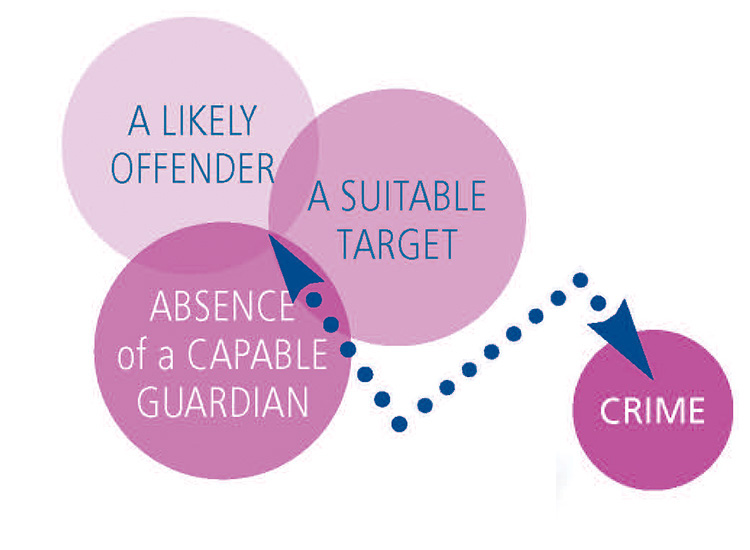Routine Activity Theory: how to protect public places
Vivian Gravenberch from the Dutch Institute of Safe and Secure Spaces explains their use of the renowned Routine Activity Theory in the protection of their public places.
 Two wise men called Marcus Felson and Lawrence Cohen once wrote (in Social Change and Crime Rate Trends: A Routine Activity Approach) that the opportunity for crime occurs when there are three elements in place. This helicopter view theory explains how any offender can be motivated to commit a crime. At the Dutch Institute of Safe and Secure Spaces (DISSS), we try to help local authorities, municipalities and other important stakeholders to grasp these kinds of helicopter view theories regarding the protection of public spaces in an understandable manner, that can be translated to their daily work.
Two wise men called Marcus Felson and Lawrence Cohen once wrote (in Social Change and Crime Rate Trends: A Routine Activity Approach) that the opportunity for crime occurs when there are three elements in place. This helicopter view theory explains how any offender can be motivated to commit a crime. At the Dutch Institute of Safe and Secure Spaces (DISSS), we try to help local authorities, municipalities and other important stakeholders to grasp these kinds of helicopter view theories regarding the protection of public spaces in an understandable manner, that can be translated to their daily work.
The likely offender
The first element of the so-called Routine Activity Theory is that of a likely offender, who can become a motivated offender when the other two elements are in place: a suitable target and the absence of a capable guardian. Their theory states that anyone could become a motivated offender, when the opportunity to commit a crime emerges.
To give an example, if a person (a likely offender) walks by an opened car window without any cameras or people around (absence of a capable guardian) and sees an envelope with a large amount of cash (a suitable target), the chances are high that this person will steal the envelope. Of the three elements that are present within the opportunity of crime, we can at least influence two: the suitable target and the (absence of a) capable guardian. By influencing these two elements, chances are high that we can also influence the third and most important element: the likely offender. By taking away the opportunity, the likely offender will not become a motivated offender.
Identifying the suitable target
The suitability of a target depends on its a) Value (for instance, if one plans a symbolic attack), b) Inertia (weight, height, can I carry it?), c) Visibility (is it exposed enough to invoke a crime?) and d) Access (a filled envelope within reach). Together, these create the easy- to-remember acronym VIVA.
Identifying a suitable target can be done in many different ways, using different types of methods and standards, but the most commonly used standards are the ISO Guidelines for Risk Management and the EU Vulnerability Assessment Tool. They provide the framework, lay out the principles and explain the process of risk management. At DISSS we also help local authorities, municipalities and other important stakeholders to grasp these types of standards and tools to identify suitable targets, regarding the protection of public spaces by training them and organising workshops about vulnerability and risk assessments. The ISO guidelines give an overview of how to manage risks in general. The process explains how one can tackle the risks (or crimes) to public space using four steps.
Step 1: What are the risks? Which types of crimes could occur? What types of likely offenders can we come across? By using crime icon stickers, local authorities and municipalities throughout Europe together identify the risks by using the interactive and innovative methods of the Secu4All project – this provides training for local authorities to provide citizens with a safe urban environment by reducing the risks in public spaces
Step 2: The earlier mentioned EU Vulnerability Assessment Tool (VAT) (DG HOME, 2019), the main objective of which is to provide practical support to member states to enhance the protection of public spaces by providing an on-site tool to scan the gaps in the security of any public space, helps with the identification and analysis of risks. Manuals to use the EU VAT have been provided by our PRoTECT project: Protection of public spaces: Manual for EU. (https://protect-cities.eu/wp-content/uploads/2021/09/PRoTECT_D4.4_Final_v3.00.pdf) and specifically for places of worship, within the ProSPeReS Manual for Vulnerability Assessment.
Step 3: Evaluating the risks means nothing more than to evaluate if the risks are low, medium or high. If the risks are low, the choice can be to leave the situation the way it is. If the risks are high, it is always highly recommended to start the next and final step within the risk assessment process.
Step 4: If the risks are high, they need to be treated. Treating the risks also creates the presence of a capable guardian.
Creating the capable guardian
Creating the capable guardian can be done before, during or after the risks take place. Creating a capable guardian works best in a preventative manner.
For instance, using guidelines from the Crime Prevention through Environmental Design Association (CPTED) or using social or technological innovations to prevent crime, such as street coaches combined with smart sensors and CCTV. At DISSS we also help local authorities and municipalities to help search and create capable guardians in the protection of their public space.
The use of sensors could help to create a capable guardian within the protection of public space. A sensor can be seen as the eyes and ears of the public space. The controller can be seen as the brain that receives the signals from the sensors and translates them to an action that in turn will be sent to the actuator; if this occurs, then that should happen. All of these parts together can be viewed as the brain of a capable guardian that protects public space; a form of artificial intelligence.
Vivian Gravenberch
Director
Dutch Institute for Safe & Secure Spaces (DISSS)
For more articles on crime prevention, see our categories Security Management and Counter Terrorism.



